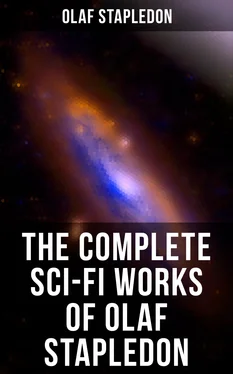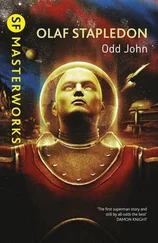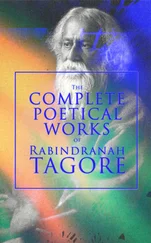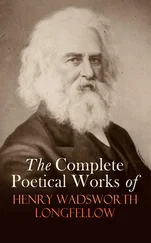Olaf Stapledon - The Complete Sci-Fi Works of Olaf Stapledon
Здесь есть возможность читать онлайн «Olaf Stapledon - The Complete Sci-Fi Works of Olaf Stapledon» — ознакомительный отрывок электронной книги совершенно бесплатно, а после прочтения отрывка купить полную версию. В некоторых случаях можно слушать аудио, скачать через торрент в формате fb2 и присутствует краткое содержание. Жанр: unrecognised, на английском языке. Описание произведения, (предисловие) а так же отзывы посетителей доступны на портале библиотеки ЛибКат.
- Название:The Complete Sci-Fi Works of Olaf Stapledon
- Автор:
- Жанр:
- Год:неизвестен
- ISBN:нет данных
- Рейтинг книги:5 / 5. Голосов: 1
-
Избранное:Добавить в избранное
- Отзывы:
-
Ваша оценка:
- 100
- 1
- 2
- 3
- 4
- 5
The Complete Sci-Fi Works of Olaf Stapledon: краткое содержание, описание и аннотация
Предлагаем к чтению аннотацию, описание, краткое содержание или предисловие (зависит от того, что написал сам автор книги «The Complete Sci-Fi Works of Olaf Stapledon»). Если вы не нашли необходимую информацию о книге — напишите в комментариях, мы постараемся отыскать её.
Novels:
Last and First Men: A Story of the Near and Far Future
Last Men in London
Odd John: A Story Between Jest and Earnest
Star Maker
Darkness and the Light
Sirius: A Fantasy of Love and Discord
Death into Life
Short Stories:
The Flames (1947)
The Seed and the Flower
The Road to the Aide Post
A Modern Magician
East is West
A World of Sounds
Arms Out of Hand
The Complete Sci-Fi Works of Olaf Stapledon — читать онлайн ознакомительный отрывок
Ниже представлен текст книги, разбитый по страницам. Система сохранения места последней прочитанной страницы, позволяет с удобством читать онлайн бесплатно книгу «The Complete Sci-Fi Works of Olaf Stapledon», без необходимости каждый раз заново искать на чём Вы остановились. Поставьте закладку, и сможете в любой момент перейти на страницу, на которой закончили чтение.
Интервал:
Закладка:
One result of the general ‘telepathic’ facility of the species was that speech was no longer necessary. It was still preserved and prized, but only as a medium of art, not as a means of communication. Thinking, of course, was still carried on largely by means of words; but in communication there was no more need actually to speak the words than in thinking in private. Written language remained essential for the recording and storing of thought. Both language and the written expression of it had become far more complex and accurate than they had ever been, more faithful instruments for the expression and creation of thought and emotion.
‘Telepathy’ combined with longevity and the extremely subtle brain-structure of the species to afford each individual an immense number of intimate friendships, and some slight acquaintance actually with the whole race. This, I fear, must seem incredible to my readers, unless they can be persuaded to regard it as a symptom of the high mental development of the species. However that may be, it is a fact that each person was aware of every other, at least as a face, or a name, or the holder of a certain office. It is impossible to exaggerate the effects of this facility of personal intercourse. It meant that the species constituted at any moment, if not strictly a community of friends, at least a vast club or college. Further, since each individual saw his own mind reflected, as it were, in very many other minds, and since there was great variety of psychological types, the upshot in each individual was a very accurate self-consciousness.
In the Martians, ‘telepathic’ intercourse had resulted in a true group-mind, a single psychical process embodied in the electro-magnetic radiation of the whole race; but this group-mind was inferior in calibre to the individual minds. All that was distinctive of an individual at his best failed to contribute to the group-mind. But in the fifth human species ‘telepathy’ was only a means of intercourse between individuals; there was no true group-mind. On the other hand, telepathic intercourse occurred even on the highest planes of experience. It was by ‘telepathic’ intercourse in respect of art, science, philosophy, and the appreciation of personalities, that the public mind, or rather the public culture, of the Fifth Men had being. With the Martians, ‘telepathic’ union took place chiefly by elimination of the differences between individuals; with the Fifth Men ‘telepathic’ communication was, as it were, a kind of spiritual multiplication of mental diversity, by which each mind was enriched with the wealth of ten thousand million. Consequently each individual was, in a very real sense, the cultured mind of the species; but there were as many such minds as there were individuals. There was no additional racial mind over and above the minds of the individuals. Each individual himself was a conscious centre which participated in, and contributed to, the experience of all other centres.
This state of affairs would not have been possible had not the world-community been able to direct so much of its interest and energy into the higher mental activities. The whole structure of society was fashioned in relation to its best culture. It is almost impossible to give even an inkling of the nature and aims of this culture, and to make it believable that a huge population should have spent scores of millions of years not wholly, not even chiefly, on industrial advancement, but almost entirely on art, science, and philosophy, without ever repeating itself or falling into ennui I can only point out that, the higher a mind’s development, the more it discovers in the universe to occupy it.
Needless to say, the Fifth Men had early mastered all those paradoxes of physical science which had so perplexed the First Men. Needless to say, they had a very complete knowledge of the geography of the cosmos and of the atom. But again and again the very foundations of their science were shattered by some new discovery, so that they had patiently to reconstruct the whole upon an entirely new plan. At length, however, with the clear formulation of the principles of psycho-physics, in which the older psychology and the older physics were held, so to speak, in chemical combination, they seemed to have built upon the rock. In this science, the fundamental concepts of psychology were given a physical meaning, and the fundamental concepts of physics were stated in a psychological manner. Further, the most fundamental relations of the physical universe were found to be of the same nature as the fundamental principles of art. But, and herein lay mystery and horror even for the Fifth Men, there was no shred of evidence that this aesthetically admirable cosmos was the work of a conscious artist, nor yet that any mind would ever develop so greatly as to be able to appreciate the Whole in all its detail and unity.
Since art seemed to the Fifth Men to be in some sense basic to the cosmos, they were naturally very much preoccupied with artistic creation. Consequently, all those who were not social or economic organizers, or scientific researchers, or pure philosophers, were by profession creative artists or handicraftsmen. That is to say, they were engaged on the production of material objects of various kinds, whose form should be aesthetically significant to the receiver. In some cases the material object was a pattern of spoken words, in others pure music, in others moving coloured shapes, in others a complex of steel cubes and bars, in others some translation of the human figure into a particular medium, and so on. But also the aesthetic impulse expressed itself in the production, by hand, of innumerable common utensils, indulging sometimes in lavish decoration, trusting at other times to the beauty of function. Every medium of art that had ever been employed was employed by the Fifth Men, and innumerable new vehicles were also used. They prized on the whole more highly those kinds of art which were not static, but involved time as well as space, for as a race they were peculiarly fascinated by time.
These innumerable artists held that they were doing something of great importance. The cosmos was to be regarded as an aesthetic unity in four dimensions, and of inconceivable complexity. Human works of pure art were thought of as instruments through which man might behold and admire some aspect of the cosmic beauty. They were said to focus together features of the cosmos too vast and elusive for man otherwise to apprehend their form. The work of art was sometimes likened to a compendious mathematical formula expressive of some immense and apparently chaotic field of facts. But in the case of art, it was said, the unity which the artistic object elicited was one in which factors of vital nature and of mind itself were essential members.
The race thus deemed itself to be engaged upon a great enterprise both of discovery and creation in which each individual was both an originator of some unique contribution, and an appraiser of all.
Now, as the years advanced in millions and in decades of millions, it began to be noticed that the movement of world-culture was in a manner spiral. There would be an age during which the interest of the race was directed almost wholly upon certain tracts or aspects of existence; and then, after perhaps a hundred thousand years, these would seem to have been fully cultivated, and would be left fallow. During the next epoch attention would be in the main directed to other spheres, and then afterwards to yet others, and again others. But at length a return would be made to the fields that had been deserted, and it would be discovered that they could now miraculously bear a millionfold the former crop. Thus, in both science and art man kept recurring again and again to the ancient themes, to work over them once more in meticulous detail and strike from them new truth and new beauty, such as, in the earlier epoch, he could never have conceived. Thus it was that, though science gathered to itself unfalteringly an ever wider and more detailed view of existence, it periodically discovered some revolutionary general principle in terms of which its whole content had to be given a new significance. And in art there would appear in one age works superficially almost identical with works of another age, yet to the discerning eye incomparably more significant. Similarly, in respect of human personality itself, those men and women who lived at the close of the aeon of the Fifth Men could often discover in the remote beginning of their own race beings curiously like themselves, yet, as it were, expressed in fewer dimensions than their own many-dimensional natures. As a map is like the mountainous land, or the picture like the landscape, or indeed as the point and the circle are like the sphere, so, and only so, the earlier Fifth Men resembled the flower of the species.
Читать дальшеИнтервал:
Закладка:
Похожие книги на «The Complete Sci-Fi Works of Olaf Stapledon»
Представляем Вашему вниманию похожие книги на «The Complete Sci-Fi Works of Olaf Stapledon» списком для выбора. Мы отобрали схожую по названию и смыслу литературу в надежде предоставить читателям больше вариантов отыскать новые, интересные, ещё непрочитанные произведения.
Обсуждение, отзывы о книге «The Complete Sci-Fi Works of Olaf Stapledon» и просто собственные мнения читателей. Оставьте ваши комментарии, напишите, что Вы думаете о произведении, его смысле или главных героях. Укажите что конкретно понравилось, а что нет, и почему Вы так считаете.












